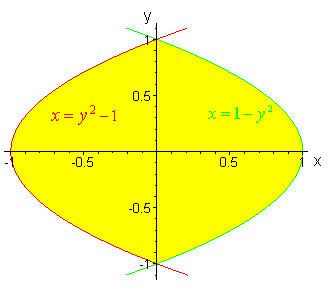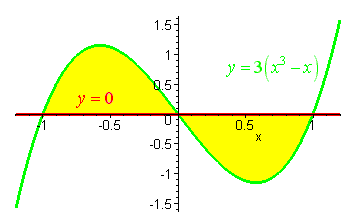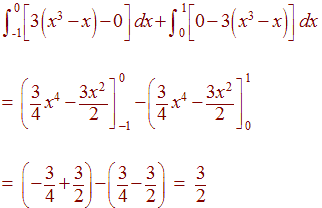Area Between Two Curves
Area Between Two Curves
Recall that the area under a curve and above the x axis can be computed by the definite integral. If we have two curves
y = f(x) and y =
g(x)
such that
f(x) > g(x)
then the area between them bounded by the horizontal
lines x = a and x = b is
|
|
To remember this formula we write
|
|
Example: 
Find the area between the curves
y = x2
and
y = x3
Solution:
First we note that the curves intersect at the points
(0,0) and (1,1). Then we see that
x3
< x2
in this interval. Hence the area is given by

= 1/3 - 1/4 = 1/12.
Exercises
-
Find the area between the curves y = x2 and y =

-
Find the area between the curves y = x2 - 4 and y = -2x
-
Find the area between the curves y = 2/x and y = -x + 3
-
Find the area between the curves y = 3x and y = 2x + 1
Area Bounded by Two Functions of y
Example: 
Find the area between the curves
x = 1 -
y2
and
x = y2 - 1
Here the curves bound the region from the left and the right. We
use the formula
|
|
For our example:
![]()

Example: Find the area between the curves
y = 0 and y = 3(x3 - x)
Solution: when we graph the region, we see that the curves cross each other so that the top and bottom switch. Hence we split the integral into two integrals:

Application
Let y = f(x) be the demand function for a product and
y = g(x) be the supply
function. Then we define the equilibrium point to be the intersection
of the two curves. The consumer surplus is defined by the area above
the equilibrium value and below the demand curve, while the producer surplus
is defined by the area below the equilibrium value and above the supply curve.
Example: 
Find the producer surplus for the demand curve
f(x) = 1,000 -
0.4x2
and the supply curve of
g(x) = 42x
Solution
We first find the equilibrium point:
We set
1,000 -
0.4x2 = 42x
or
0.4x2 + 42x - 1,000 = 0
We get
x = 20
hence
y = 42(20) = 840
We integrate
![]()
= 8400